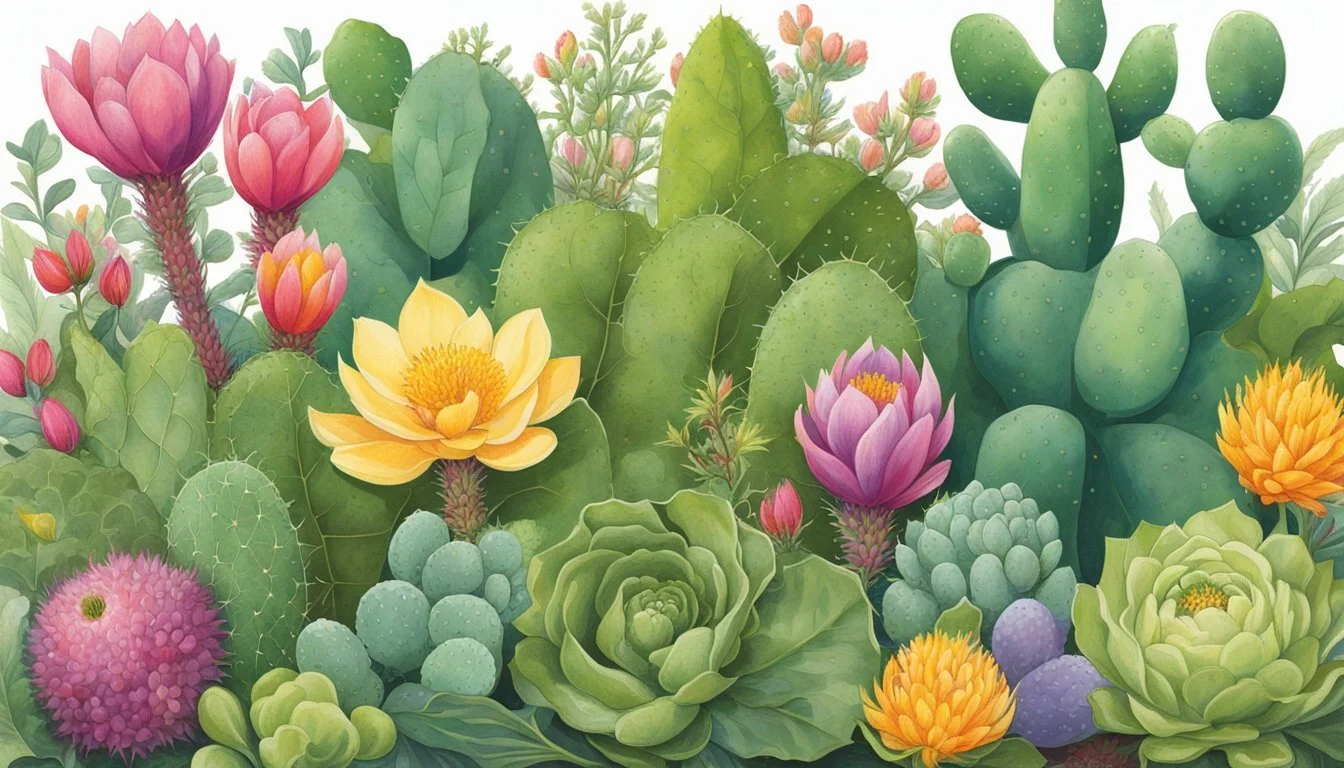Front Range Native Edible Plants
A Guide to Foraging and Enjoyment
Exploring the rich biodiversity of the Colorado Front Range reveals an assortment of native edible plants that can be incorporated into local landscapes. Integrating these plants into gardens not only provides a sustainable food source but also supports native wildlife and promotes climate resilience. For those interested in enhancing their gardens with edible native species, the Front Range offers a plethora of options.
Among the notable plants are wild plums, serviceberries, and nettles, all of which thrive in the Colorado climate. These plants are not only functional but also add aesthetic value to any garden. Native shrubs like chokecherry and herbs such as wild mint bring both utility and beauty to landscaping projects.
Planting native edibles in your garden can transform it into a haven for both people and local fauna. By selecting species well-suited to Colorado's unique environment, gardeners can ensure vibrant growth and a bountiful harvest, all while conserving water and maintaining ecological balance.
Understanding the Front Range Ecosystem
The Front Range of Colorado is a unique area where various life zones and plant communities coexist. Urbanization poses significant challenges to these native flora, influencing biodiversity and ecosystem health.
Life Zones and Plant Communities
The Front Range features multiple life zones, each hosting distinct native plant communities. The transition from plains to alpine areas underscores the region's biodiversity.
Plains: This area is dominated by grasses, wildflowers, and low shrubs. Species such as Achillea millefolium (yarrow) and Allium (wild onions) thrive here.
Foothills: Slightly higher, the foothills support species like Archtostaphylos uva-ursi (kinnikinnick) and Artemesia (sagebrushes).
Montane: This zone hosts Ponderosa pines, Douglas firs, and Showy Milkweed (Asclepias speciosa).
Impact of Urbanization on Native Flora
Urbanization fragments habitats, making it challenging for native plant communities to thrive. The expansion of cities disrupts the natural ecosystem, reducing available land for native species.
Pollution and pesticide use further affect plant health. Urban gardens can help mitigate these effects if they incorporate native species. Educating the public about the benefits of using native plants in urban landscapes promotes biodiversity and supports local wildlife.
The growth of urban areas also introduces invasive species, which can outcompete native flora. Efforts to conserve native plant communities must include managing invasive species and restoring natural habitats.
Benefits of Native Edible Plants
Native edible plants offer a myriad of advantages for both the ecosystem and the gardener. These benefits include enhancing biodiversity, supporting local wildlife, and promoting sustainability without requiring extensive maintenance.
Biodiversity and Wildlife Support
Native edible plants are integral to local ecosystems. They have co-evolved with local wildlife, providing crucial food sources and habitats. For instance, Achillea millefolium (yarrow) and Archtostaphylos uva-ursi (kinnikinnick) produce berries and leaves that attract various insects and birds.
This mutual relationship bolsters biodiversity, as multiple species depend on these plants. Pollinators such as bees and butterflies are particularly drawn to these plant species, which helps maintain pollination cycles that are vital for the ecosystem's balance.
Additionally, using native plants in gardens reduces the need for pesticides. They are naturally resistant to local pests, fostering a healthier environment for wildlife. By supporting local flora, gardeners contribute to sustaining native fauna and preserving ecological integrity.
Sustainability and Low Maintenance
Native edible plants are uniquely adapted to local climates and soils, making them more sustainable. These plants often require less water and fewer soil amendments. For example, American cranberry shrubs thrive in colder climates with consistently moist, acidic soils.
Using native plants reduces the reliance on external resources like fertilizers and intensive watering. This practice is environmentally friendly and more cost-effective for gardeners.
Furthermore, native plants tend to have lower maintenance needs. Since they are well-suited to their environment, they face fewer stressors from climate and pests, resulting in healthy growth with minimal intervention. This low-maintenance aspect allows gardeners to enjoy productive and beautiful landscapes with less effort.
Identifying Native Edible Plants
Identifying native edible plants in the Front Range involves recognizing a diverse array of wildflowers, herbs, shrubs, trees, grasses, and groundcovers that are both nutritious and sustainable.
Wildflowers and Herbs
Wildflowers and herbs play a significant role in the edible landscape of the Front Range. Edible wildflowers like violets offer both beauty and utility. Their blooms make a colorful addition to salads and desserts.
Wild herbs such as sage and thyme are common. They are used in cooking and make excellent teas. Yarrow is another valuable herb, known for its medicinal properties.
It's crucial to correctly identify these plants to avoid confusing them with look-alikes that might be toxic. Resources like field guides can aid in proper identification, ensuring safe foraging.
Shrubs and Trees
Edible shrubs and trees provide an abundant source of food. The American cranberry shrub, for instance, thrives in the cooler climate and acidic soil of the Front Range. Its berries are tart and used in sauces and preserves. Another remarkable tree is the serviceberry, which bears sweet, purple fruits enjoyed fresh or dried.
Pawpaw and persimmon trees also offer edible fruits. Nuts from trees like the black walnut are another staple, providing a rich source of protein and fats. Identifying these plants involves paying attention to distinctive features such as leaf shape, bark texture, and fruit characteristics.
Grasses and Groundcovers
Grasses and groundcovers might not be the first plants to come to mind, but some are indeed edible. Plants like wild garlic and wild onions are prevalent, adding a flavor punch to various dishes.
Groundcovers such as strawberries are not only delicious but also serve as an effective way to prevent soil erosion. Purslane, a common groundcover, is notable for its high omega-3 fatty acid content. Accurate identification is essential, especially since some grasses and groundcovers might be mistaken for non-edible or even harmful species.
Creating Your Native Edible Garden
Creating a native edible garden involves careful planning, selecting appropriate plants, maintaining them, and considering wildlife habitats. This approach merges beauty with practical benefits, supporting sustainable landscapes and enhancing biodiversity.
Planning and Landscape Design
When planning your garden, begin with a soil test to understand its pH and type. Native plants, like American cranberries, often need specific conditions, such as acidic and consistently moist soil.
Layout considerations are crucial. Place taller plants to avoid shading shorter ones. A raised bed or tiered garden structure can optimize space and improve drainage.
Paths and edging materials help define spaces. Mulched pathways can help with soil moisture retention and weed control. The integration of wine cap mushrooms can further improve soil quality and water retention through their decomposing action.
Plant Selection and Culture
Selecting the right plants is essential. For Front Range landscapes, consider species adapted to local climates like:
American Cranberry: Requires cool, moist conditions and acidic soil.
Wine Cap Mushrooms: Thrive in mulched areas, contributing to soil improvement.
Choose perennial greens, fruits, and tubers. These plants need less replanting, reducing maintenance time. Consider intertwining fruiting shrubs with other edibles to maximize space.
Spacing is vital for healthy growth. Follow specific plant spacing guidelines for each type of plant to avoid overcrowding, which can lead to disease.
Maintenance and Care
Regular maintenance keeps your native edible garden thriving. This includes:
Watering: Maintain consistent moisture levels. Drip irrigation systems can be very effective.
Weeding: Use organic mulch to minimize weeds and retain soil moisture.
Pruning: Especially for fruit-bearing plants and shrubs, ensure proper airflow and sunlight penetration.
Monitoring for pests is necessary. Native plants often attract beneficial insects that help control pests naturally, reducing the need for chemical interventions.
Wildlife Habitat Creation
Creating a garden that attracts and supports wildlife is part of a sustainable landscape. Use native plants to provide food and shelter for local wildlife.
Habitat features like bird baths, bee hotels, and dense shrubbery can attract birds, bees, and beneficial insects. For example, berries from native shrubs offer essential food for birds.
Incorporating a mix of plant types, including flowering varieties, supports pollinators throughout the growing season. This approach not only benefits the environment but also enhances the productivity of your edible garden.
Featured Native Edible Plants
The Front Range of Colorado offers various native edible plants that are both beneficial and attractive for landscaping. This section highlights specific groups such as Allium Species, Berry-Producing Varieties, and Select Perennials and Cacti to help gardeners make informed choices.
Allium Species
Allium, or wild onions, thrive in the Front Range, offering both aesthetic appeal and culinary uses. Allium cernuum, also known as nodding onion, produces pink to lavender flowers and has a mild onion flavor. The entire plant is edible, from the bulb to the slender leaves. Suitable for rock gardens, they prefer well-drained soil and full sun.
Lesser-known species like Allium textile also grow well in this region. These plants provide crucial nectar for pollinators while being easy to cultivate. They have medicinal properties and can be used similarly to their more common relatives in cooking.
Berry-Producing Varieties
Several native plants produce edible berries, providing food for both humans and wildlife. Prunus virginiana (chokecherry) yields tart berries that are excellent for jams and syrups. This shrub grows well at higher elevations and prefers moist soil.
Rubus idaeus, commonly known as wild raspberry, produces sweet berries ideal for eating fresh or preserving. It grows in thickets and requires well-drained soil and partial shade.
Another noteworthy plant is Arctostaphylos uva-ursi (kinnikinnick), which produces small, red berries. These berries are edible but more often used in traditional remedies. The plant serves as a low-growing ground cover, flourishing in sandy soils.
Select Perennials and Cacti
Among the perennials, Solidago (goldenrod) stands out, known for its bright yellow flowers and versatile uses. Though the flowers are not typically consumed, the young shoots and leaves can be eaten cooked. Geranium viscosissimum (sticky geranium) has edible roots that can be used in a variety of dishes.
Cacti, such as the Opuntia species (prickly pear), offer edible pads and fruit. The pads, known as nopales, are a staple in Mexican cuisine, while the fruit is used in jellies and candies. These cacti are drought-resistant, making them ideal for xeriscaping.
Eriogonum umbellatum (sulfur buckwheat) is another perennial to consider. It produces yellow flowers and has leaves that can be brewed into teas. Lastly, Monarda fistulosa (wild bergamot) offers leaves and flowers that are used for flavoring dishes and making herbal teas.
These plants not only enrich the landscape but also provide practical uses for gardeners and nature enthusiasts alike.
Integrating Edibles into Your Existing Landscape
Incorporating edible plants into your landscape can be both beautiful and practical. This approach enables homeowners to grow their own food while maintaining an aesthetically pleasing yard.
Companion Planting
Companion planting involves growing certain plants together to enhance their growth, deter pests, or provide support. Vegetables, herbs, and fruits can complement each other when planted strategically.
For instance, pairing tomatoes with basil not only saves space but also improves the flavor of tomatoes and repels pests. Similarly, planting beans near corn allows the beans to use the corn stalks as natural supports, while marigolds can ward off nematodes and aphids. This technique maximizes yield and reduces the need for chemical fertilizers and pesticides.
Pocket Gardens and Containers
Pocket gardens and container-grown plants allow for flexible, space-efficient gardening. They can be placed on patios, balconies, or tucked into small areas of the yard. These gardens are perfect for growing herbs like thyme, oregano, and parsley, as well as small fruiting plants such as strawberries and bush tomatoes.
Containers should have good drainage and be filled with quality soil to ensure healthy plant growth. Use a mix of perennials and annuals to keep the garden productive throughout the year. This method is especially useful for those with limited space or who want to create a dynamic, movable garden experience.







